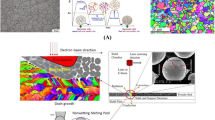Abstract
Fracture toughness testing of materials at the micrometer scale has become essential due to the continuing miniaturization of devices accompanied by findings of size effects in fracture behavior. Many techniques have emerged in the recent past to carry out fracture toughness measurements at the relevant micro and nanolength scales, but they lack ASTM standards that are prescribed for bulk scale tests. Also, differences in reported values arise at the microscale due to the sample preparation technique, test method, geometry, and investigator. To correct for such discrepancies, we chose four different fracture toughness test geometries in practice, all of them micromachined in the focused ion beam (FIB), to investigate the fracture toughness of Si(100) at the micrometer scale. The average KIC that emerges from all four cases is a constant (0.8 MPa m1/2). The advantages and limitations of each of these geometries in terms of test parameters and the range of materials that can be tested are discussed.




Similar content being viewed by others
References
G. Dehm, C. Motz, C. Scheu, H. Clemens, P.H. Maryhofer, and C. Mitterer: Mechanical size effects in miniaturized and bulk materials. Adv. Eng. Mater. 8 (11), 1033–1045 (2006).
O. Kraft, P.A. Gruber, R. Moenig, and D. Weygand: Plasticity in confined dimensions. Annu. Rev. Mater. Res. 40, 293–317 (2010).
J.R. Greer and J.D. Hosson: Plasticity in small scale metallic systems: Intrinsic vs extrinsic size effect. Prog. Mater. Sci. 56 (6), 654–724 (2011).
A.H. Chokshi, A. Rosen, J. Karch, and H. Gleiter: On the validity of Hall-Petch relationship in nanocrystalline materials. Scr. Metall. 23, 1679–1684 (1989).
C.E. Carlton and P.J. Ferreira: What is behind the inverse Hall-Petch effect in nanocrystalline materials?Acta Mater. 55, 3749–3756 (2007).
C.P. Chen and M.H. Leipold: Fracture toughness of Si. Am. Ceram. Soc. Bull. 59, 469–472 (1980).
F. Ebrahimi and L. Kalwani: Fracture anisotropy in silicon single crystal. Mater. Sci. Eng., A 268, 116–126 (1999).
S. Sundararajan and B. Bhushan: Development of AFM based techniques to measure mechanical properties of nanoscale structures. Sens. Actuators, A 101, 338–351 (2002).
T. Ando, X. Li, S. Nakao, T. Kasai, H. Tanaka, M. Shikida, and K. Sato: Fracture toughness measurement of thin film silicon. Fatigue Fract. Eng. Mater. Struct. 28, 687–694 (2005).
M. Tanaka, K. Higashida, H. Nakashima, H. Takagi, and M. Fujiwara: Orientation dependence of fracture toughness measured by indentation methods and its relation to surface energy in single crystal silicon. Int. J. Fract. 139, 383–394 (2006).
R.O. Ritchie: Failure of silicon: Crack formation and propagation. In 13th Workshop on Crystalline Solar Cell Materials and Processes, Vail, Colorado, 2003.
ASTM E 1820-01: Standard test method for measurement of fracture toughness. In Ann Book ASTM Std, Vol. 03.01, 2001, pp. 1–46.
A. Yawny, J. Malarria, E. Soukup, and M. Sade: Stage for in-situ mechanical loading experiments in a scanning electron microscope with a small chamber. Rev. Sci. Instrum. 68, 1500154 (1997).
B.N. Jaya and M.Z. Alam: Small-scale mechanical testing of materials. Curr. Sci. 105, 1073–1099 (2013).
J.E.P. Ipina and A.A. Yawny: In-situ observation of damage evolution and fracture toughness measurement by SEM. In Damage Prognosis for Aerospace, Civil and Mechanical Systems, edited by D. J. Inman, D. J. Farrar, V. Lopes, Jr, and V. Steffen, Jr. (2005); pp. 61–73.
R. Podor, J. Ravaoux, and H. Brau: In-situ experiments in the scanning electron microscope chamber. In Scanning Electron Microscopy, edited by V. Kazmiruk. (InTech, 2012); pp. 32–54.
B.N. Jaya, S. Bhowmick, S.A.S. Asif, O.L. Warren and V. Jayaram: Optimisation of clamped beam geometry for fracture toughness testing of micron-scale samples. Philos(2015, in press). DOI.10.1080/14786435.2015.1010623.
W.C. Oliver and G.M. Pharr: An improved technique for determining hardness and elastic modulus using load and displacement sensing indentation experiments. J. Mater. Res. 7, 1564–1583 (1992).
K.J.V. Vliet, L. Prchlik, and J.F. Smith: Direct measurement of indentation frame compliance. J. Mater. Res. 19, 325–331 (2004).
S.A.S. Asif, K.J. Wahl, and R.J. Colton: Nanoindentation and contact stiffness measurement suing force modulation with a capacitive load-displacement transducer. Rev. Sci. Instrum. 70, 2408–2413 (1999).
D. Kupka: Fracture experiments of single grain boundaries in ductile metals. PhD Thesis, Helmholtz-Zentrum Geesthacht, Germany, 2013.
E. Huerta, J.E. Corona, A.I. Oliva, F. Aviles, J. Gonzalez-Hernandez: Universal testing machine for mechanical properties of thin materials. Rev. Mex. Fis. 56 (4), 317–322 (2010).
A.C. Fischer-Cripps: Nanoindentation, 2nd ed. (Springer, New York, NY, 2004).
C.M. Peret and J.M. Rodrigues: Stability of crack propagation during bending tests on brittle materials. Ceramica 54, 382–387 (2008).
K. Matoy, H. Schoenherr, T. Detzel, R. Pippan, C. Motz, and G. Dehm: A comparative microcantilever study of the mechanical behavior of silicon based passivation films. Thin Solid Films 518, 247–256 (2009).
B.N. Jaya, V. Jayaram, and S.K. Biswas: A new method for fracture toughness determination of graded (Pt, Ni)Al bond coats by microbeam bend tests. Philos. Mag. 92, 3326–3345 (2012). Special Issue: Nano-mechanical testing in materials research and development III.
S. Liu, J.M. Wheeler, P.R. Howie, X.T. Zeng, J. Michler, and W.J. Clegg: Measuring the fracture resistance of hard coatings. Appl. Phys. Lett. 102, 1719071–1719074 (2013).
M. Sebastiani, K.E. Johanns, E.G. Herbert, F. Carasitti, and G. M Pharr: A novel pillar indentation splitting test for measuring fracture toughness of thin ceramic coatings. Philos. Mag. (2014). DOI: 10.1080/14786435.2014.913110.
B.N. Jaya and V. Jayaram: Crack stability in edge notched clamped beam specimen: Modeling and experiments. Int. J. Fract. 188, 213–228 (2014).
M.A. Hopcroft, W.D. Nix, and T.W. Kenny: What is the Young’s modulus of Si?J. Microelectromech. Syst. 19, 229–238 (2010).
S. Timoshenko and J.N. Goodier: Theory of Elasticity, 2nd ed. (McGraw-Hill, New York, NY, 1951).
M. Sebastiani: Private communication, 2014.
H. Li and J.J. Vlassak: Determining the elastic modulus and hardness of an ultra-thin film on a substrate using nanoindentation. J. Mater. Res. 24, 1114–1126 (2009).
D. Di Maio and S.G. Roberts: Measuring fracture toughness of coatings using focused-ion-beam-machined microbeams. J. Mater. Res. 20, 299–302 (2005).
K. Takashima and Y. Higo: Fatigue and fracture of a Ni-P amorphous alloy thin film on the micrometer scale. Fatigue Fract. Eng. Mater. Struct. 28, 703–710 (2005).
T.P. Halford, D. Rudinal, K. Takashima, and Y. Higo: The effect of sample preparation upon the fracture toughness of microsized TiAl. Key Eng. Mater. 297–300, 2416–2422 (2005).
S. Wurster, C. Motz, and R. Pippan: Characterisation of fracture toughness of micron-sized tungsten single crystal notched specimens. Philos. Mag. 92, 1803–1825 (2012).
F. Iqbal, J. Ast, M. Goeken, and K. Durst: In-situ microcantilever tests to study fracture properties of NiAl single crystals. Acta Mater. 60, 1193–1200 (2012).
D.E.J. Armstrong, A.J. Wilkinson, and S.G. Roberts: Micro-mechanical measurements of fracture toughness of bismuth embrittled copper grain boundaries. Philos. Mag. Lett. 91 (6), 394–400 (2011).
M. Mueller: Microscopic chevron-notch fracture test of alumina reinforcements. Nanobruecken (2014).
F. Iqbal: Fracture mechanisms of γ-TiAl alloys investigated by in-situ experiments in a scanning electron and atomic force microscope. PhD Thesis, Universität Erlangen-Nürnberg, Erlangen, Germany, 2012.
I.C. Noyen and J.B. Cohen: Residual Stress Measurement by Diffraction and Interpretation (Springer-Verlag, New York, 1987).
A. Brenner and S. Senderoff: Calculation of stress in electrodeposits from the curvature of a plated strip. J. Res. Natl. Bur. Stand. 42, 105–123 (1949).
J.W. Ager III and M.D. Drory: Quantitative measurement of residual biaxial stress by Raman spectroscopy in diamond grown on a Ti alloy by chemical vapor deposition. Phys. Rev. B. 48, 2601–2607 (1993).
W. Fang and J. Wickert: Determining mean and gradient residual stresses in thin films using micromachined cantilevers. J. Micromech. Microeng. 6, 301–309 (1996).
M. Sebastiani, E. Bemporad, F. Carasitti, and N. Schwarzer: Residual stress measurement at the micrometer scale: Focused ion beam milling and nanoindentation testing. Philos. Mag. 91, 1121–1136 (2011).
W. Beres, A.K. Koul, and R. Thamburaj: A tapered double cantilever beam specimen designed for constant K-testing at elevated temperatures. J. Test. Eval. 25, 536–542 (1997).
E.N. Brown: Use of the tapered double-cantilever beam geometry for fracture toughness measurements and its application to the quantification of self-healing. J. Strain Anal. Eng. Des. 46, 167–186 (2010).
Y. Qiao: PhD Thesis, MIT, 2002.
H.H. Gatzen and M. Beck: Investigations on the friction force anisotropy of the silicon lattice. Wear 254, 1122–1126 (2003).
G.M. Pharr: The anomalous behavior of silicon during nanoindentation. Mater. Res. Soc. Symp. Proc. 239, 301–312 (1992).
W.W. Gerberich, D.D. Stauffer, A.R. Beaber, and N.I. Tymiak: A brittleness transition in silicon due to scale. J. Mater. Res. 27, 552–567 (2012).
Z. Han, K. Zheng, Y.F. Zhang, Z. Zhang, and Z.L. Wang: Low temperature in-situ large strain plasticity of silicon nanowires. Adv. Mater. 19, 2112–2118 (2007).
F. Oestlund, K.R. Malyska, K. Leifer, L.M. Hale, Y. Tang, R. Ballarini, W.W. Gerberich, and J. Michler: Brittle to ductile transition in uniaxially compression of silicon pillars at room temperature. Adv. Funct. Mater. 19, 2439–2444 (2009).
P. Gludovatz, S. Wuster, A. Hoffmann, and R. Pippan: A study into the crack propagation resistance of pure tungsten. Eng. Fract. Mech. 100, 76–85 (2013).
T. Tsuchiya, J. Sakata, and Y. Taga: Tensile strength and fracture toughness of surface micromachined polycrystalline silicon thin films prepared under various conditions. MRS Symp. Proc. 505, 285–290 (1997).
R.J. Myers and B.M. Hillberry: Effect of notch root radius on the fracture behavior of monocrystalline silicon. In Proceedings, 4th International Conference on Fracture, Waterloo, Canada, Vol. 3, 1001–1005 (1977).
W.N. Sharpe, B. Yuan, and R.L. Edwards: Fracture tests of polysilicon film. MRS Symp. Proc. 505, 51–56 (1997).
S. Rubanov and P.R. Munroe: FIB induced damage in silicon. J. Microsc. 24, 213–221 (2004).
H. Kahn, N. Tayebi, R. Ballarini, R.L. Mullen, and A. H. Heuer: Fracture toughness of polysilicon MEMS devices. Sens. Actuators, A 82, 274–280 (2000).
I. Chasiotis, S.W. Cho, and K. Jonnalagadda: Fracture toughness and subcritical crack growth in polycrystalline silicon. J. Appl. Mech. 73, 714–722 (2005).
ACKNOWLEDGMENTS
The authors would like to gratefully acknowledge Dr Marco Sebastiani, Roma Tre, Italy for providing the γ value for calculation of KI in the pillar splitting experiment.
Author information
Authors and Affiliations
Corresponding author
Rights and permissions
About this article
Cite this article
Jaya, B.N., Kirchlechner, C. & Dehm, G. Can microscale fracture tests provide reliable fracture toughness values? A case study in silicon. Journal of Materials Research 30, 686–698 (2015). https://doi.org/10.1557/jmr.2015.2
Received:
Accepted:
Published:
Issue Date:
DOI: https://doi.org/10.1557/jmr.2015.2




